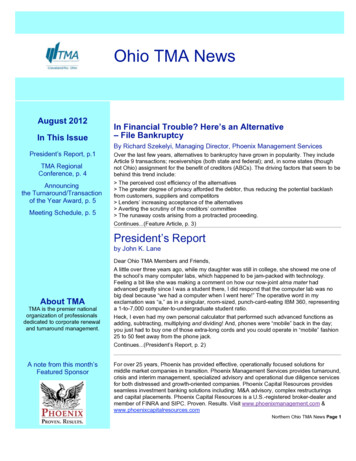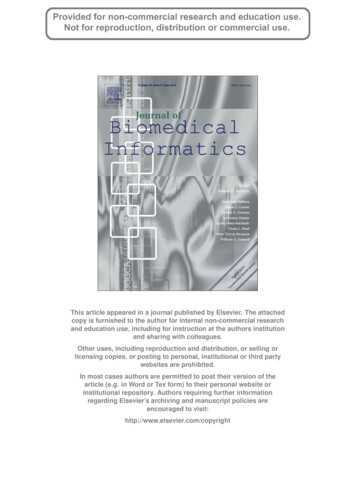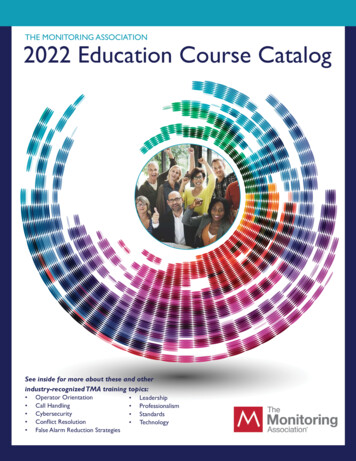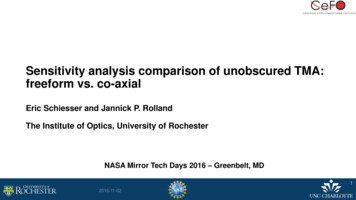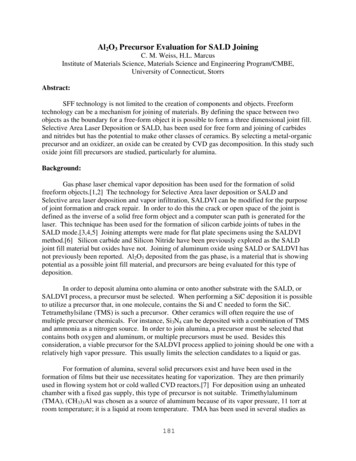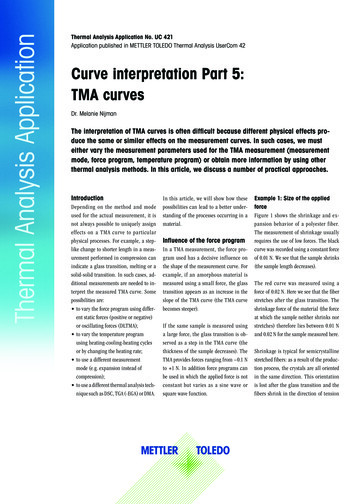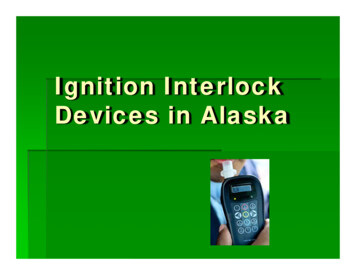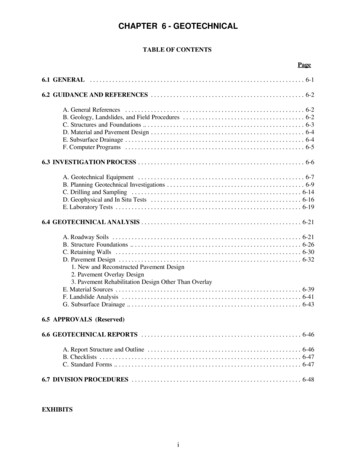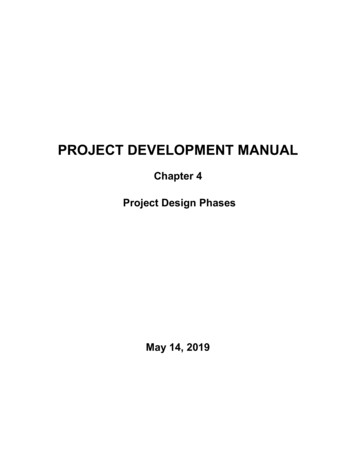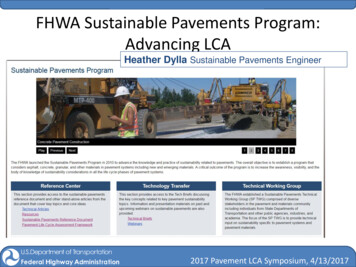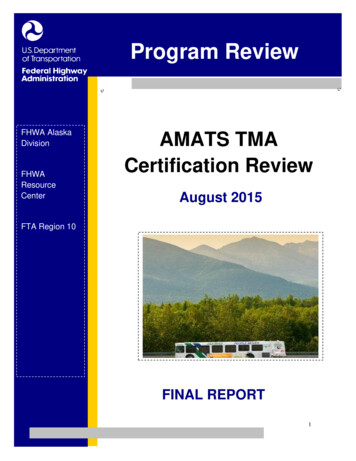
Transcription
Program ReviewFHWA AlaskaDivisionFHWAResourceCenterAMATS TMACertification ReviewAugust 2015FTA Region 10FINAL REPORT1
EXECUTIVE SUMMARYThe U.S. Department of Transportation (USDOT) is required to review and evaluate thetransportation planning process of transportation management areas no less than once every fouryears. The review is conducted by a team of representatives from the Federal HighwayAdministration (FHWA) and Federal Transit Administration (FTA). It consists of anexamination of the Metropolitan Planning Organization’s (MPO) documented practices,procedures, guidelines and activities followed by a field review that includes meetings with theMPO management, partners and staff, a public input session, and report on the findings andrecommendations of the Review Team. The review culminates in a joint statement ofcertification by the FHWA and FTA.In January 2015, the Review Team provided the Anchorage Metropolitan Area TransportationSolutions (AMATS) with a preliminary list of questions and documentation needs correspondingto the major topics of interest in the review. In follow up, AMATS staff provided detailedwritten responses to the Review Team’s questions. On March 3 - 4, 2015, the Review Teamconducted an on-site visit with MPO and State agency staff as well as the general public.The previous review completed in January 2012 resulted in four corrective actions. This reviewfound that the previous corrective actions from have been implemented or substantial progresshas been made and the corrective action activities are continuing. There were no new correctiveactions identified in this review. The outcome of this review is: The Federal TransitAdministration and the Federal Highway Administration jointly certify that the planningprocess conducted by the Anchorage Metropolitan Area Transportation Solutions meetsthe requirement of 23 CFR 450, Section 334(b)(i).Previous Findings and DispositionThe 2011 review resulted in four findings requiring corrective actions:1. Congestion Management Process – Two areas that are not adequately addressed by thecurrent CMP include 1) identification of an implementation schedule, implementationresponsibilities, and possible funding sources for each selected strategy; and 2)implementation of a process for periodic assessment of the efficiency and effectiveness ofimplemented strategies. These elements should be incorporated as part of the CMPduring the update of the LRTP.AMATS’ Resolution: While the Congestion Management Process has not been fullyupdated, substantial progress has been made. A comprehensive update is beingperformed through a consultant contract. Completion is expected before December31, 2015, and this review will be held open until completion of this item.2. Financial Planning and Fiscal Constraint – The LRTP must provide adequatedocumentation of methods and assumptions used to determine the full capital as well asmaintenance and operational cost for all travel modes over the life of the LRTP. Inaddition, adequate documentation is needed of the methods used to determine projectedrevenue sources and identify strategies for ensuring availability of proposed new2
revenues. These enhancements to the financial plan element should be addressed as partof the upcoming LRTP update.AMATS’ Resolution: The complex public private partnership funding of the KnikArm Bridge has changed since the previous update of the LRTP. The currentfunding plan is a more conventional mix of state bonds, TIFIA, and FHWA funds.AMATS has developed a good tool to evaluate fiscal constraint in the MTP. Revisedfinancial constraint documentation will be included in the upcoming LRTP update.3. Title VI – AMATS shall develop assurances that the program will be conducted incompliance with all requirements imposed by Title VI and the related laws andregulations. These assurances, a Title VI implementation plan and complaint procedures,should be developed with guidance from the Alaska Department of Transportation andPublic Facilities (DOT&PF) by 06/01/2012. It should include a Limited EnglishProficiency (LEP) Needs Assessment to develop an AMATS LEP policy.AMATS’ Resolution: AMATS addressed this corrective action by developing aTitle VI Nondiscrimination Implementation Plan that includes a complaintprocedure and a LEP Policy.4. Intelligent Transportation Systems – AMATS has not adopted a maintenance plan for theregional ITS architecture. 23 CFR 940.9(f) requires a MPO to develop and implementprocedures and responsibilities for maintaining regional architecture, as needs evolvewithin the region. The ITS subcommittee formation and the regional ITS architectureupdates are opportunities to develop and implement a maintenance plan for the regionalarchitecture. Procedures and responsibilities for maintaining the regional architectureneeds to be developed by 01/01/2013.AMATS’ Resolution: The ITS update is not complete, but substantial progress hasbeen made. A comprehensive update is being performed through a consultantcontract. The ITS update will be finished before December 31, 2015, and thisreview will be held open until completion of this item.There are no findings that require a corrective action as a result of the 2015 review. In theremainder of this report, the term “findings” will not indicate a compliance issue that requires acorrective action. Rather, the term “findings” will mean statements of fact that define theconditions found during the data-gathering phase of the review. The Review Team has providedrecommendations for several of the subject areas, and has attached comments and documentsreceived during the public meeting on March 3, 2015.DESCRIPTION AND OVERVIEW OF MPOAMATS was first designated as a metropolitan planning area in 1976. The Governor of the Stateof Alaska, per the Intergovernmental Agreement signed in December 2002 by the AlaskaDepartment of Transportation and Public Facilities (DOT&PF) and the Municipality ofAnchorage, and in accordance with the federal regulation coded in 23 CFR §450, designated3
AMATS. The Operating Agreement was last amended by the AMATS Policy Committee onJune 28, 2012.The Municipality fulfills its dual roles as the recognized MPO and Air Quality Planning Agencyfor the Anchorage Maintenance Area through AMATS. The participant groups in the AMATSplanning and decision-making process are: the AMATS Policy Committee; the AMATSTechnical Advisory Committee; the Municipal Planning and Zoning Commission; the AMATSFreight Advisory Committee; the Municipal Assembly; and AMATS staff.The Anchorage Urbanized Area is made up of the densely populated areas of the Municipality.The Metropolitan Planning Area (MPA) encompasses a major portion of the political boundariesof the Municipality of Anchorage. The MPA is bounded on the north by Knik Arm, on the eastby the Chugach Mountains, on the south by Turnagain Arm, and on the west by Cook Inlet.When designated in 1976, AMATS only included the Anchorage Bowl, but the Metro Area wasexpanded in the late 1980s to include the rapidly developing area of EagleRiver/Chugiak/Birchwood/Eklutna and the predominately residential area south of Rabbit CreekRoad. The only population centers within the Municipality that are outside the AMATS StudyArea are the Turnagain Arm communities of Girdwood, Bird and Indian. The area covered isapproximately 1,697 square miles. Policy Committee Chair: Rob CampbellMember Jurisdictions and Number Represented: The MPO Policy Committee includesthree members from the Municipality of Anchorage (Mayor and two Assembly members)and two members from the State (Department of Environmental Conservation AirQuality Manager and DOT&PF Regional Director)Population Served: Approximately 300,000Major Transit Operators: The public transit system includes People Mover (fixed route),AnchorRIDES (paratransit), and Share-A-Ride (vanpool).Major Projects/Plans: AMATS is working on a new Metropolitan Transportation Plan(MTP) and an interim MTP update simultaneously. Also working on CongestionManagement Process, ITS architecture, a Freight Plan update, and Spenard Corridor planwhich combines land use and transportation.Study Area Organizational Structure (23 CFR 450.310)Regulatory Basis:Federal legislation (23 USC 134(b); Section 49 USC 5303)) requires the designation of aMetropolitan Planning Organization (MPO) for each urbanized area with a population of morethan 50,000 individuals. The policy board of the MPO shall consist of (A) local elected officials,(B) officials of local agencies that administer or operate major modes of transportation within thearea, and (C) appropriate State officials.Upon designation of a MPO as a TMA the policy board shall be structured to include (A) localelected officials, (B) officials of local agencies that administer or operate major modes oftransportation within the area, and (C) appropriate State officials. A new requirement in the4
Moving Ahead for Progress in the 21st Century Act (MAP-21) requires representation byproviders of public transportation in MPOs that serve TMAs.Findings:The Policy Committee is comprised of five members: two Assembly members, selected by thatbody; the Mayor of Anchorage; the Governor’s designee for Air Quality (Alaska Department ofEnvironmental Conservation (ADEC) Air Quality Program Manager; and the Governor’sdesignee for Transportation (Alaska Department of Transportation & Public Facilities CentralRegion Director. Each member of the policy board has one vote.The Technical Advisory Committee meets monthly and provides recommendations to the PolicyBoard and is composed of 11 members. There is a standing Chairperson from the Municipalityof Anchorage.The Municipality of Anchorage, Public Transportation Department provides publictransportation within the metropolitan area. The public transit system includes People Mover(fixed route), Anchor RIDES (paratransit), and Share-A-Ride (vanpool). Additionally, ValleyMover provides commuter transit service from the Mat-Su Borough to Anchorage. The AlaskaRailroad also provides passenger rail service along with freight transportation within theplanning area.All major modes of transportation are represented on the AMATS Policy Committee with theexception of Valley Mover which is based in the Mat-Su Borough and provides commuter transitservice from the borough to Anchorage.The Municipality’s Public Transportation Department is generally represented on the PolicyCommittee by the Mayor and Assembly members. Note: AMATS is exempt from the MAP-21requirement to have direct representation by providers of public transportation, as certified byletter dated September 25, 2014.Corrective Actions:NoneRecommendations/ Comments:The Federal Review Team recommends that the roles and responsibilities of thevarious technical, policy and citizen committees be clarified and documented inconcert with the current update of the Operating Agreement.Metropolitan Planning Boundaries (23 CFR 450.312)Regulatory Basis:Federal legislation (23 USC 134(c): 49 USC 5303(d) requires boundaries of a metropolitanplanning area to be determined by agreement between the MPO and the Governor. Eachmetropolitan planning area shall encompass at least the existing urbanized area and the5
contiguous area expected to become urbanized within a 20 year forecast period; and mayencompass the entire metropolitan statistical area or consolidated metropolitan statistical area, asdefined by the Bureau of the Census.Findings:There is only one recognized tribal entity in the AMATS area: Native Village of Eklutna. Theyare included in planning in the same way as all other groups and organizations.The primary federal land holdings within the AMATS planning area include Elmendorf AirForce Base and Fort Richardson Army Base.Chugach State Park abuts the AMATS boundaries and AMATS has included the Chugach StatePark regional planner in regional planning meetings.The MPO boundaries were modified in 2013 to reflect census tracts from the 2010 Census.Corrective Actions:NoneRecommendations/ Comments:NoneAgreements and Contracts (23 CFR 450.314)Regulatory Basis:Federal legislation (23 USC 134) requires the Metropolitan Planning Organization (MPO) towork in cooperation with the State and public transportation agencies in carrying out acontinuing, cooperative, and comprehensive (3C) metropolitan planning process. These agenciesdetermine their respective and mutual roles and responsibilities and procedures governing theircooperative efforts. Federal regulations require that these relationships be specified inagreements between the MPO and the State and between the MPO and the public transitoperators. The regulations also require an agreement between the MPO and any other agencyresponsible for air quality planning under the Clean Air Act. A single agreement should beexecuted among the MPO, State, transit operators, and designated air quality regulations “to theextent possible.” 23 CFR 450.314(a).Findings:The Transit Operator is part of the MPO, is represented on the MPO Technical AdvisoryCommittee, and is a party to the AMATS Operating Agreement.Air quality planning is a joint work effort through AMATS between Municipal Health andHuman Services, the ADEC and the DOT&PF. Air quality planning is directed out of theAMATS Operating Agreement.6
AMATS also has an agreement with the State of Alaska, Knik Arm Crossing Project related touse of the AMATS Travel Demand Model.There is only one recognized tribal entity in the AMATS area: Native Village of Eklutna (NVE).AMATS has an agreement with the NVE for transportation planning purposes.While there is no set schedule for updating the AMATS operating agreement, it is checked fromtime to time to ensure it is up to date. AMATS is considering an amendment to their operatingagreement to create a stand-alone Citizens Advisory Committee, appointed by the AMATSPolicy Committee.The other agreements that AMATS is a party to through the Municipality of Anchorage arereviewed periodically by the Municipal Managers office and the Municipal Department of Lawto ensure they are current and accurate.The Anchorage/Mat-Su Borough Regional Transit Authority Plan (December 2011) examinedthe feasibility of establishing a regional transit authority and developed a guide for anorganization structure for regional transportation services in Southcentral Alaska.Corrective Actions:NoneRecommendations/ Comments:The Federal Review Team recommends that AMATS consider developing anagreement with the Mat-Su Borough to define and clarify modeling protocols andprocedures, including applicable model uses and updates, data collection andsharing, validation techniques and socio-economic forecasting procedures.Discussions regarding the potential creation of a regional transit authority shouldcontinue to be investigated as transportation demand increases between the AMATSarea and the Mat-Su Borough.Unified Planning Work Program (UPWP) (23 CFR 450.308)Regulatory Basis:MPOs are required to develop the UPWPs in cooperation with the State and public transitagencies [450.308(c)]. Elements to be included in the UPWP are: Discussion of the planning priorities facing the metropolitan planning area Description of all metropolitan transportation planning and transportation related airquality planning activities anticipated within the next 1 or 2 year period, regardless offunding source or agencies conducting activities, indicating who will perform the work,the schedule for completion of the work, and what the intended product is.7
Findings:In accordance with AMATS’ adopted public involvement program, the UPWP undergoes publicreview during an annual 30-day public review and comment period.AMATS has utilized FHWA Metropolitan Planning (PL) funds, FHWA Statewide Planning &Research (SPR funds for DOT&PF Central Region), FHWA Surface Transportation Program(STP) funds in various categories, including Congestion Mitigation & Air Quality (CMAQ), andTransportation Enhancements, FTA Sections 5303, 5307, 5310, 5337 and 5339, and FHWAEarmarks for Intelligent Transportation Systems (ITS).Recent UPWPs have included more detail and timelines showing estimated completion dates.AMATS has worked to provide the document earlier to FHWA and FTA for review to ensureadequate time for approval.Corrective Actions:NoneRecommendations/Comments: Include estimated expenditures to conduct the documented work activities as part ofthe UPWP work element descriptions as well as in the summary financial table.Provide an early draft of the UPWP to FHWA and FTA for review and comment.Consider including a prospectus at beginning of document. This section woulddescribe the near-term as well as longer-term priority work tasks and issues facingAMATS in overview terms to inform partners and stakeholders.Transportation Planning Process (23 CFR 450.306, 316 & 318)Regulatory Basis:Federal regulations 23 CFR 450.306 and 450.318 define the scope of the metropolitantransportation planning process and the relationship of corridor and other subarea planningstudies to the metropolitan planning process and National Environmental Policy Act (NEPA)requirements. In addition, 23 CFR 345.316 (c)(d) and (e) address the need for participation byFederal lands management agencies and Tribal governments in the development of key productsin the planning process. Key provisions of 23 CFR 450.306 are related to required planningfactors, coordination, and consistency with related planning processes, asset management, andpossible differences in requirements for TMAs and non-TMAs.8
Findings:For the 2035 MTP developed under the SAFETEA-LU requirements for expanded consultation,staff contacted resource agencies including the Bureau of Land Management and Native Villageof Eklutna directly and requested their review and comment of proposed recommendations.All technical and policy information is posted on the AMATS homepage and noticed via emaillist, along with our newspaper advertising. All of the AMATS meetings and work sessions areopen public meetings with ample opportunity for public comment.The AMATS Operating Agreement requires a minimum 30 day public comment period for allplans and programs. Any updates to the AMATS Public Participation Plan require a 45 daypublic comment period.The Freight Advisory Committee (FAC) was re-established in January 2009. Committeemembers represent local carriers, haulers, aviation, military, port, tourism, and other freightoperators. This group offers comments on many planning documents such as the 2035Metropolitan Plan, site plans, engineering designs, and other AMATS efforts.AMATS selected Cambridge Systematics to produce an updated performance based andobjectives-driven CMP to meet federal planning regulations and is consistent with the MAP-21legislation (2012), and that builds on previous AMATS congestion management efforts andplanned activities.The 2035 MTP consolidated the LRTPs for the Anchorage Bowl and Chugiak-Eagle River.Representatives from Chugiak-Eagle River were included on the TAC.KAC financial information was provided to AMATS staff for inclusion in the 2035 MTP at anoverall planning level. Detailed project financial information was not included as it wasconsidered at too great a level of detail for planning purposes.Corrective Actions:NoneRecommendations/ Comments: AMATS should continue to refine its performancemeasures to key measures, clearly identify how measures are used to identifystrategies/projects and evaluate progress toward targets established as part of a broadbased performance management planning process.Metropolitan Transportation Plan (MTP) Development (23 CFR450.322)Regulatory Basis:9
Federal regulations require the development of a MTP as a key product of the metropolitanplanning process: The metropolitan transportation planning process shall include thedevelopment of a transportation plan addressing no less than a 20-year planning horizon. Thetransportation plan shall include both long-range and short-range strategies/actions that lead tothe development of an integrated multimodal transportation system to facilitate the safe andefficient movement of people and goods in addressing current and future transportation demand.[23 CFR 450.322]. The MTP is to be updated every four years in nonattainment and maintenanceareas and every five years in attainment areas to ensure its consistency with changes in land-use,demographic, and transportation characteristics.Findings:The 2035 Metropolitan Transportation Plan was adopted by the AMATS Policy Committee inMay 2012; the next update is due by May 2016.AMATS is working on an interim MTP to be approved before December 31, 2015 so theexisting horizon year will still account for a 20-year period. The interim MTP will includeupdated fiscal constraint analysis to account for new funding estimates and project costestimates.A comprehensive MTP update with a horizon year of 2040 will be developed by December2017.AMATS Transportation Planning staff is under the Community Development Department(CDD) of the Municipality of Anchorage. The CDD includes Current, Long-Range andTransportation Planning Divisions and AMATS staff often consults with those other divisions,particularly regarding land use issues.The staff of the DOT&PF, Central Region, was active participants in the development of theMTP. DOT&PF staff participated in the planning project as well as served on the TechnicalOversight Committee.Recommendations of the Freight Advisory Committee (FAC) are included as an element of theMetropolitan Transportation Plan. The MTP dedicates specific chapters to existing freightconditions, deficiencies, and future projects. AMATS plans to solicit proposals from qualifiedconsultants to provide professional planning services for the preparation of the AMATS FreightMobility Study (FMS).The Non-Motorized Transportation Plan is an element of the MTP and consists of three distinctstudies, which include the Anchorage Pedestrian Plan, the Anchorage Bicycle Plan, and theAnchorage Trails Plan. At this time, the Anchorage Pedestrian Plan and the Anchorage BicyclePlan are completed.The AMATS Travel Demand Model is a traditional 4-step gravity model integratingsocioeconomic indicators to forecast traffic generation, distribution, mode-choice, and10
assignment. This model includes all modes of travel (walk, bicycle, transit, freight, passengervehicle – Auto alone, Auto driver with passenger, Auto passenger, Public Transit/School Bus,Walk, Bike).The AMATS model underwent a peer review in 2004 and was calibrated and validated in 2005.The AMATS Travel Demand Model is undergoing an update.The 2035 MTP represented the consolidation of the Anchorage Bowl LRTP and Chugiak-EagleRiver LRTP, and addressed and maintained sub-regional priorities and values.The 2035 MTP outreach for security focused on outreach to the State of Alaska Division ofHomeland Security & Emergency Management office. The 2040 MTP will address security in amore in-depth fashion.AMATS staff is working more closely with Municipality of Anchorage (MOA) Long-RangePlanning and Public Transportation Planning staff to identify opportunities to collaborate onimplementation of Transit Supportive Corridors, in particular, and on land use, particularly in thecurrent update to the MOA Land Use Map. During the transportation model update, MOA staffworked with Matanuska-Susitna Borough (MSB) staff on land use assumptions for the MSB.Knik Arm Crossing project (KAC) financial information at a planning level was included in the2035 MTP for revenues and costs over the life of the project.The 2040 MTP RFP includes a task for the consultant to assist AMATS with recommendationsfor how to approach estimations for GHG emissions.Corrective Actions:NoneRecommendations/ Comments:The proposed KAC project must be accomplished within the financial constraint ofthe MTP, based on documentation in a project-level financial plan approved byFHWA. The MTP update scheduled for completion in December 2017 shouldinclude updated cost estimates (design, construction, operation, maintenance) andanticipated revenue sources to support the revised KAC financial plan.AMATS has a good spreadsheet tool to analyze and demonstrate financialconstraint, but it is not easily understood by the public. To ensure that the financialinformation is clearly understood by policy-makers as well as the general public, asummary table(s) should be developed for the MTP that provides key financial data,including sources and uses of all funds by various timeframes.11
Congestion Management Process (CMP) (23 CFR 450.320)Regulatory Basis:An effective CMP is a systematic process for managing congestion that provides information ontransportation system performance and on alternative strategies for alleviating congestion andenhancing the mobility of persons and goods to levels that meet State and local needs. The CMPresults in serious consideration of implementation of strategies that provide the most efficientand effective use of existing and future transportation facilities. In both metropolitan andnonmetropolitan areas, consideration needs to be given to strategies that reduce SOV travel andimprove existing transportation system efficiency. Where the addition of general purpose lanes isdetermined to be an appropriate strategy, explicit consideration is to be given to theincorporation of appropriate features into the SOV project to facilitate future demandmanagement and operational improvement strategies that will maintain the functional integrity ofthose lanes. 23CFR 450.320(b)Findings:The CMP methodology provides a process to track system performance, measure the costeffectiveness of strategies, allocate scarce resources, and give decision makers, from theAMATS Technical Advisory Committee, the Assembly and other stakeholders, such as thepublic and local, state, and federal agencies, information on how the transportation system isworking. During the update to the 2040 MTP, Transportation Planning staff will coordinate andintegrate the CMP with the MTP.AMATS selected Cambridge Systematics to produce an updated performance based andobjectives driven CMP to meet federal planning regulations and is consistent with the MovingAhead for Progress in the 21st Century (MAP-21) legislation (2012), and that builds on previousAMATS congestion management efforts and planned activities. All 8 steps of the CMP process,according to the FHWA CMP Guidebook, are addressed in the contract, and along with thepreparation of the Status of the System Report anticipated to be completed by October, 2015.AMATS is currently collecting travel times for all modes of transportation, level of service forhighways and intersections, and travel times on specific road segments, facilities types, andcorridors. AMATS and Cambridge have developed regional objectives, identified the CMP areaand network, outlined multimodal performance measures, prepared a data management plan,performed a gap analysis, evaluated appropriate CMP strategies, and developed animplementation plan and schedule.To address freight needs, AMATS also obtains cargo tonnage, annual passenger enplanements,in-transit cargo, and enplaned cargo from the Ted Stevens Anchorage International Airport, thePort of Anchorage, and the Alaska Railroad.System upgrade of signal control technology is underway and includes updated controlequipment, management software, real-time communications, and a traffic management center.12
Automatic collection of traffic volumes and monitoring will enable MOA traffic engineers tocontinuously be aware of actual traffic patterns and quickly adapt to them.The MPO collects crash data from difference sources: internal municipal agency (AnchoragePolice Department), University of Alaska Anchorage, Anchorage Airport Police and Fire,DOT&PF Commercial Vehicle Enforcement and Highway Information Group and the AlaskaState Troopers. The MPO also uses some Highway Safety Improvement Program factors fromthe State of Alaska to assist in the creation of safety statistics.Currently the MPO uses a traffic data management system to house all collected information.This system allows for monitoring changes such as: volumes, speeds, classifications, traveltimes, crashes, etc. Applicable information from this system is utilized in the AMATS model topredict the flow and trend of traffic, including the major freight movements.Corrective Actions:NoneRecommendations/ Comments:The Federal Review Team is pleased to hear about the contractor-led update of theCMP and recommends full implementation of the FHWA/FTA suggested 8-stepframework (An Interim Guidebook on the Congestion Management Process inMetropolitan Transportation Planning, February 2008). Current efforts to furtherdevelop the CMP should be coordinated with FHWA/FTA to ensure the previouscorrective action is addressed adequately. Specifically, two areas of the CMP thatneed direct attention include: identification of an implementation schedule andresponsibilities, and establishment of a process for periodic assessment of identifiedstrategies.Transportation Improvement Program (TIP) (23 CFR 450.324, 326 & 328)Regulatory Basis:The MPO is required, under 23 CFR 450.324, to develop a TIP in cooperation with the State andpublic transit operators. The TIP must cover a period of at least four years and must be approvedby the MPO and the governor. If the TIP is updated more frequently, the cycle must becompatible with the State Transportation Improvement Program (STIP) development andapproval process [23 CFR 450.324(a)]. The following information must be provided for eachproject included in the TIP: sufficient descriptive material to identify the project or phase;estimated total cost; amount of Federal fund proposed to be obligated during each program year;proposed source of Federal and non-Federal funds; identification of funding recipient/project13
sponsor; in nonattainmen
1 Program Review AMATS TMA Certification Review FINAL REPORT August 2015 FHWA Alaska Division FHWA Resource Center FTA Region 10
